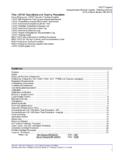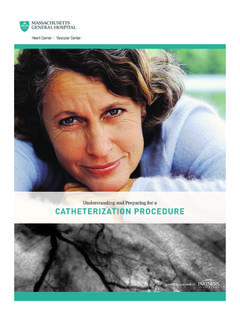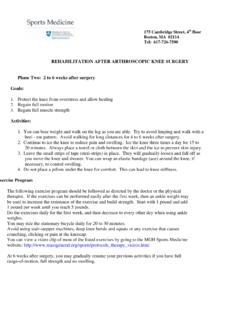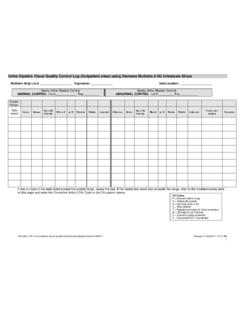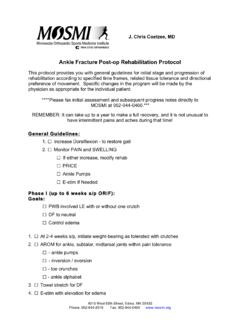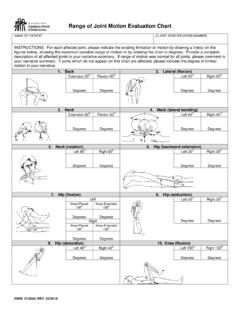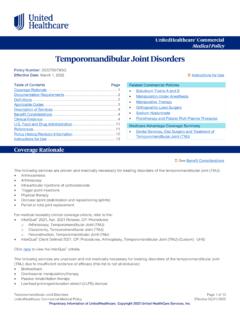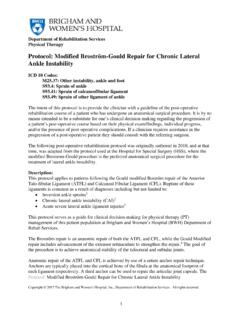Transcription of Physical Therapy Guidelines for Ankle Fracture with Surgery
1 Physical Therapy Guidelines for Ankle Fracture with Surgery This was written and developed by the therapists of MGH Physical Therapy Services. The information is the property of Massachusetts General Hospital and should not be copied or otherwise used without express permission of the Director of MGH Physical & Occupational Therapy Services. For the Clinician: The intent of this protocol is to provide the clinician with a guideline of the post-operative rehabilitation for the patients who undergo Surgery for an Ankle Fracture . It is not intended to be a substitute for clinical decision making regarding the progression of a patient s post-operative course based on their examination/findings, individual progress, and/or the presence of post-operative complications. If a clinician requires assistance in the progression of a post-operative patient, they should consult with the referring surgeon.
2 For the Patient: The timeframes for expected outcomes contained within this guideline may vary from patient to patient based on individual differences, Fracture type surgical techniques, surgeon s preference, additional procedures performed, and/or complications. Compliance with all the recommendations provided by your physician and Physical therapist as well as your active participation in all parts of the rehabilitation process, are essential to optimizing the success of this procedure. Introduction: Ankle fractures represent the most common types of lower extremity bony injury with an incidence between 100 and 150 per 100,000 person-years (and rising). Most often, Ankle fractures occur due to a quick twisting injury where the foot is planted on the ground and the body rotates around it. Sometimes in addition to the bony Fracture around the Ankle which involves the malleoli, patients can sustain significant ligamentous injuries that require Surgery as well.
3 This is typically at the discretion of the surgeon who bases this decision on the patient s level of overall instability of the injury. Stability and congruency of the Ankle joint are the main factors that determine prognosis and overall management. Stable, non-displaced fractures are typically managed non-operatively, while displaced, unstable Ankle fractures typically require open reduction and internal fixation. Ankle Anatomy: Figure 1: Figure 2: Figure 3: Normal Ankle Typical Stable Ankle Fracture Typical Unstable Ankle Fracture Surgical Procedure: Displaced, unstable fractures are often best served by open ORIF. Immediately following Surgery , patients are typically restricted in weight bearing on the involved limb and wear a short leg splint, cast or boot for an average of 6-12 weeks, per the surgeon s discretion.
4 Almost all people who sustain Ankle fractures experience some loss of range of motion (ROM), strength and muscle recruitment problems, some of which will benefit from Physical Therapy . Good communication with the surgeon and understanding your post operative precautions are important for maximizing functional outcomes. Fractures involving the joint surface called pilon fractures have a more conservative care plan after Surgery . Reference: Physical Therapy Guidelines for Ankle Fracture with Surgery This was written and developed by the therapists of MGH Physical Therapy Services. The information is the property of Massachusetts General Hospital and should not be copied or otherwise used without express permission of the Director of MGH Physical & Occupational Therapy Services. Phase Restrictions and Precautions Physical Therapy Treatment Goals Pre-operative -Non weight-bearing (NWB) -Instruct with use of assistive device based on gait assessment, NWB on affected side -Demonstrate safe ambulation with assistive device NWB -Able to maintain NWB with transfers and stairs Post-operative.
5 0-3 weeks -Non weight-bearing -Boot/cast per MD -Edema management -Gait training and safety (emphasize precautions with weight bearing) -Education/modifications for ADLs -Manage swelling -Demonstrate safe ambulation with assistive device NWB -Able to maintain NWB with transfers and stairs -Perform ADLs in a modified independent manner or with minimal assistance 3-6 weeks -Weight bearing advancement and activity restrictions per MD/ Fracture type -Boot/cast per MD -Exercises and hands-on techniques (by the PT) for foot and Ankle active and passive range of motion -Strengthening for core, hips, knees (maintain precautions) -Weight shifting with boot and assistive device (maintain precautions) -Gait training to ensure safety and to normalize pattern as weight bearing is allowed -Manage swelling -Increase range of motion of foot and Ankle -Minimize the loss of strength in the core, hips, and knees -Independence with home exercise program to be performed daily 6-12 weeks -Weight bearing status and activity restrictions per MD/ Fracture type -Boot/brace per MD -No impact or torsional exercises/activities - Ankle active/passive range of motion, stretching.
6 And strengthening exercises - joint mobilization techniques by the PT to restore motion of the foot and Ankle -Activity progression per PT instructions -Proprioception and balance exercises -Gait training to wean off the assistive devices and normalize gait -Full range of motion foot and Ankle -Good strength and adequate length of foot and Ankle muscles -A normalized gait pattern on all surfaces (wean from boot/brace when healing is adequate) -Gradually return to regular activities if ROM, strength, and gait pattern are sufficient 12-16 weeks -None if healing complete -Continue treatment as above -Single leg activities on varying surfaces -Progress as deemed appropriate by PT with resistive exercise and weight bearing activities -Advance functional training to include sports specific movement patterns -Good balance and control on the involved leg in all planes -Return to all activities (not sports) provided strength, gait and ROM goals have been met 16-20 weeks -None if healing complete -Continue treatment as above -Sports specific training and conditioning (low impact) -Gradual return to minimal or low impact sports (cycling, rowing, swimming, Stairmaster, elliptical)
7 4-6 months -None if healing complete -Continue treatment as above -Sport specific training and conditioning (progress to high impact if applicable as tolerated) -Gradual return to high impact sports (jogging, running, jumping) -Gradual return to activities with multi-planar movements on uneven outdoor surfaces (hiking) Physical Therapy Guidelines for Ankle Fracture with Surgery This was written and developed by the therapists of MGH Physical Therapy Services. The information is the property of Massachusetts General Hospital and should not be copied or otherwise used without express permission of the Director of MGH Physical & Occupational Therapy Services. If you have any questions or concerns related to the content of these rehabilitation Guidelines , please contact: MGH Physical and Occupational Therapy Services (MG Waltham) 781-487-3800 Website: MGH Orthopedics Foot and Ankle 617-724-9338 Website.
